
H
0
5 km
Haverhill
N
44 00'
Enlarged
A Apex Point
IV III W II
P
Area
H Haverhill Bridge
Z
L USA CRREL, Fixed Observation
I
O Orford Bridge
00
A 15
00
P Piermont Bridge
V
15
S Summit of N.H. Rte. 10
Indian X
W Place of Most Frequent Least Temperature
Z. Fixed Observation Site
Pond
I-X Locations of Basins Cited in Text
O
VI
NEW
VII
VERMONT
HAMPSHIRE
43 50'
0
VIII
50
Figure 3. Topography of the study area east of
the Connecticut River (left panel). The loca-
tions of observation stations are designated on
1000
the right panel. The alphanumeric point desig-
S
nators, roman numeral basin designators, and
IX
place names coordinate all figures and tables
L
in Parts I, II, and III. "Enlarged area" is shown
Hanover
in detail in Figure 9.
43 40'
ho 4/8/94c
ses to examine the consistency of the data and the
Baker et al. (1991, 1992) investigated the depth
applicability of albedo generalization in this ter-
of snow necessary to influence albedo over agri-
rain. Most of the days with >30 cm of snow oc-
cultural land; 5 cm snow was sufficient to mask
curred in February during the 1990-1993 winters.
bare ground, but 15 cm was required to mask
This is considered in comparison with the Magono
alfalfa. Baker et al. (1992) noted a systematic re-
et al. (1982) and Maki et al. (1986) Hokkaido ex-
duction of air temperature over snow cover with
periments above snow cover which usually ex-
respect to bare ground, and that 10 cm of snow
cover was accompanied by 8.4C diminution in
ceeded 1 m in depth.
The location of the experiment is noted by Z in
mean temperature. Kung et al. (1964) considered
Figure 1. Observation and measuring sites used
5 in. (12.5 cm) of snow to be sufficient to achieve a
in this research are plotted on a map in Figure 3.
uniform snow albedo. These works were consid-
Points cited in the text are named or alphanu-
ered, in conjunction with local experience, in the
merically designated for coordination with other
formulation of Table 1. The snow depth and cover
figures and maps in Parts II and III. Fixed record-
parameters defined in Table 1 will be used with
ing sites, measuring sites, and important features
air temperature parameters to objectively exam-
are designated by capital letters. Small basins sur-
ine air temperature-snow cover interaction. The
rounding observation points are designated by
<1-cm and < 3-cm snow depth categories are com-
Roman numerals. Three hamlets, Piermont,
bined for the analyses, as bare ground is domi-
Orford, and Lyme, are noted by name. These will
nant in both cases. The 3- to 10-cm and 10- to
be considered in defining the reference tempera-
30-cm categories approximate the Baker et al. and
Kung albedo criteria. Additional 10- to 20- and
ture along the river plane.
20- to 30-cm depth categories are used in the analy-
4



 Previous Page
Previous Page
